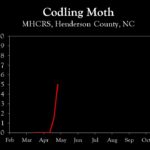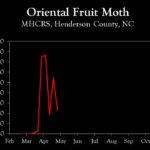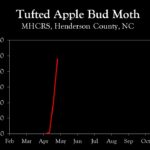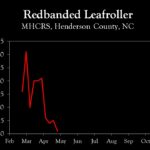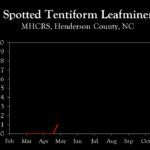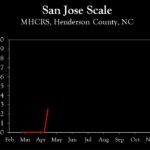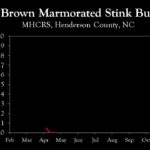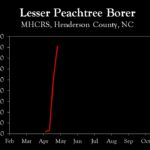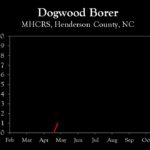WNC Orchard Insect Pest Populations – April 28, 2025
go.ncsu.edu/readext?1070023
en Español / em Português
El inglés es el idioma de control de esta página. En la medida en que haya algún conflicto entre la traducción al inglés y la traducción, el inglés prevalece.
Al hacer clic en el enlace de traducción se activa un servicio de traducción gratuito para convertir la página al español. Al igual que con cualquier traducción por Internet, la conversión no es sensible al contexto y puede que no traduzca el texto en su significado original. NC State Extension no garantiza la exactitud del texto traducido. Por favor, tenga en cuenta que algunas aplicaciones y/o servicios pueden no funcionar como se espera cuando se traducen.
Português
Inglês é o idioma de controle desta página. Na medida que haja algum conflito entre o texto original em Inglês e a tradução, o Inglês prevalece.
Ao clicar no link de tradução, um serviço gratuito de tradução será ativado para converter a página para o Português. Como em qualquer tradução pela internet, a conversão não é sensivel ao contexto e pode não ocorrer a tradução para o significado orginal. O serviço de Extensão da Carolina do Norte (NC State Extension) não garante a exatidão do texto traduzido. Por favor, observe que algumas funções ou serviços podem não funcionar como esperado após a tradução.
English
English is the controlling language of this page. To the extent there is any conflict between the English text and the translation, English controls.
Clicking on the translation link activates a free translation service to convert the page to Spanish. As with any Internet translation, the conversion is not context-sensitive and may not translate the text to its original meaning. NC State Extension does not guarantee the accuracy of the translated text. Please note that some applications and/or services may not function as expected when translated.
Collapse ▲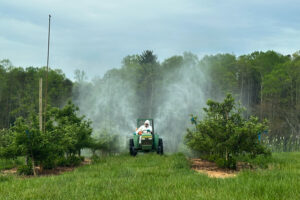 With petal fall sprays completed throughout the region, the focus for the next few weeks will be on first generation codling moth. The codling moth degree-day model predicts egg hatch from 250 DD to about 1,000 DD. Currently, degree-day accumulations in lower elevation locations (e.g., Cleveland County) are predicted to reach 250 DD this Wednesday (April 30), while in Henderson County 250 is not predicted until May 7.
With petal fall sprays completed throughout the region, the focus for the next few weeks will be on first generation codling moth. The codling moth degree-day model predicts egg hatch from 250 DD to about 1,000 DD. Currently, degree-day accumulations in lower elevation locations (e.g., Cleveland County) are predicted to reach 250 DD this Wednesday (April 30), while in Henderson County 250 is not predicted until May 7.
The number of insecticide applications and choice of materials to apply will depend on: 1) whether or not mating disruption is being used, 2) the intensity of codling moth populations in individual orchards, and 3) weather conditions. The best decisions are made when pheromone traps are being used to monitor the intensity of populations, and use of the codling moth degree-day model to time applications with egg hatch of the first generation.
Mating Disruption: In orchards where mating disruption has been used for 3 or more years, codling moth populations are typically so low that insecticides are usually not needed. However, pheromone trapping is still recommended to confirm the absence of moth activity and/or detect the “unexpected.” We recommend a threshold of at least 3 cumulative moths captured over a 2-week period to dictate supplemental insecticide sprays under mating disruption (see below for lure types).
Non-Disruption Orchards: Where mating disruption is not being used for codling moth, pheromone trapping is especially important to monitor the intensity of moth populations and help determine frequency of insecticide use during the first generation. While there is not a well established relationship between moth populations and damage, a conservative threshold level of 5 moths over a one week period (using a CM L2 lure) has been successful in minimizing damage.
Pheromone Traps: The type of trap and pheromone lure used is important for codling moth monitoring programs. Either wing traps or Delta traps are recommended. Delta traps are easier to use since they have sticky cards (liners) that easily slide into and out of the trap. Plus the Delta trap provides better protection against rain. Placing traps in the upper one-third of the canopy is recommended, because moth activity is concentrated in this area. Finally, there are several types of pheromone lures available for purchase, but our recommendations have all been developed using the Trece CM L2 lure, which has a 2X rate of pheromone and should be replaced at 8-week intervals. A longer lasting lure (CM L2-P) that needs to be replaced at 12-week intervals has recently been developed and performs similarly to the CM L2.
The number of traps to deploy needs to be a compromise between detection of moths when populations are low and what is practical. One trap per 10 acres of orchard is considered the minimum, but location is probably more important. Traps should be placed at locations where moth numbers are suspected of being high, such as near packing houses, bin storage areas, or adjacent to nearby abandoned orchards.
Codling Moth Degree-Day Model: A codling moth degree-day (DD) model that predicts egg hatch of each generation was developed in the 1970s in Michigan, and has been a key tool used to time insecticide applications. The original model has been refined and updated with phenology data to different regions, including western NC. First generation egg hatch is predicted to occur from about 250 DD through 1,000 DD. However, the length of egg hatch varies considerably depending on the size of the population. Models were developed using high population densities, and only under this scenario does egg laying occur over the entire period from 250 to 1000 DD; hence, the importance of using traps to monitor the intensity of populations.
Insecticide Options: Since 2008, the apple industry has relied primarily on two groups of insecticides for codling moth control – the diamides (Altacor, Exirel, and Verdepryn) and spinosyns (Delegate). While some resistance has been detected in more northern apple areas, to date none has been suspected in the southeast. Relying on only one mode of action (diamides versus spinosyns) during a respective generation has been a good resistance management strategy. It should be noted that under low to moderate codling moth populations, initial egg hatch can occur later than 250, so using an alternative insecticide at 250 DD can help to further minimize use of the diamides and spinosyns. Among the alternatives, Assail and Imidan are the most effective alternatives. An advantage of Assail is that it also has San Jose scale activity.
Relative Efficacy of Insecticides for Codling Moth
| Mode of Action Category | Trade Name (common) | Efficacy Rating | Comments |
| Diamides | Altacor (chlorantraniliprole) | Excellent | If using a product against 1st generation, do not use against 2nd generation, or vice versa. |
| Exirel (cyantraniliprole) | Excellent | ||
| Verdepryn (cyclaniliprole) | Excellent | ||
| Spinosyns | Delegate (spinetoram) | Excellent | If using a product against 1st generation, do not use against 2nd generation, or vice versa. Can flare woolly apple aphid populations. |
| Neonicotinoids | Assail (acetamiprid) | Very Good | Also has San Jose scale activity. |
| Organophosphates | Imidan (phosmet) | Good | |
| Diacylhydrazines | Intrepid (methoxyfenozide) | Good | Should be used at 16 oz/acre for codling moth. |
| Benzoylureas | Rimon (novaluron) | Good | Can flare European red mite populations. |
| Baculoviruses | Cyd-X HP (Cydia pomonella virus) | Should be used preventively. Organically approved. |
Learn more about southeastern apple insect pests at the Apple Insect Management page.
2025 Average Weekly Trap Captures
| HENDERSON COUNTY | |||
| Insects per trap | |||
| Apr 14 | Apr 21 | Apr 28 | |
| Codling moth | 0.0 | 1.5 | 5.0 |
| Oriental fruit moth | 18.5 | 54.5 | 23.0 |
| Tufted apple bud moth | 1.0 | 20.0 | 48.0 |
| Redbanded leafroller | 4.0 | 5.0 | 1.0 |
| Obliquebanded leafroller | n/a | n/a | set |
| Lesser appleworm | n/a | n/a | set |
| Apple maggot (research orchards) | n/a | n/a | n/a |
| Apple maggot (abandoned orchard) | n/a | n/a | n/a |
| Brown marmorated stink bug (commercial) | n/a | n/a | n/a |
| Brown marmorated stink bug (unsprayed research orchard) | 0.0 | 0.0 | 0.0 |
| Spotted tentiform leafminer | 0.0 | 0.0 | 1.0 |
| Dogwood borer | n/a | 0.0 | 1.0 |
| Peachtree borer | n/a | n/a | set |
| Lesser peachtree borer | 3.0 | 51.0 | 81.0 |
| San Jose scale | 0.0 | 0.0 | 2.5 |
*Note that these averages illustrate only the timing of insect emergence and fluctuations in populations, and are not representative of population levels in any given orchard. The only way to have an accurate assessment of an individual orchard’s populations is to set up traps in that orchard.
2025 Accumulated Degree Days
| HENDERSON COUNTY | ||||
| Apr 14 | Apr 21 | Apr 28 | ||
| Codling moth (Biofix: April 21) | n/a | Biofix | 116 | |
| Oriental fruit moth (Biofix: March 17) | 304 | 413 | 546 | |
| Tufted apple bud moth (Biofix: April 14) | Biofix | 111 | 224 | |



